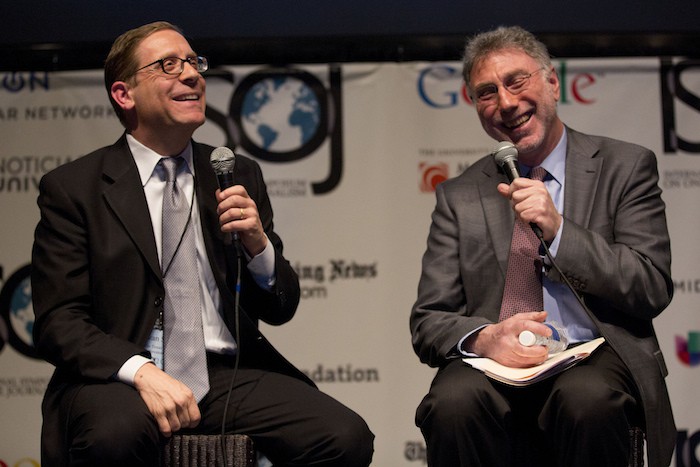
The Texas Tribune is taking its split with The New York Times pretty well.
Two months ago the Times ended its story-sharing agreement with the Austin-based news nonprofit after four years. Now, the Tribune has a new dance partner: The Washington Post. The Post and The Texas Tribune will begin a new partnership in January that will see the news outlets sharing stories, swapping data visualizations, and teaming up to hold events based on the news.
For the Post, this gives the paper a new source of reporting on Texas politics and continues the digital expansion strategy that has been one of the hallmarks of the Jeff Bezos era. For the Tribune, the partnership provides a new home for their reporting outside the state of Texas. And, in a more practical sense, it’s providing at least one Tribune reporter a home; the nonprofit’s new Washington, D.C. bureau chief, Abby Livingston, will work out of the Post newsroom.
“When The New York Times partnership ended we saw an opportunity to pursue another teammate,” Texas Tribune editor Emily Ramshaw told me. A few phone calls between Austin and Washington, and the partnership was in place, Ramshaw said.“It’s an efficient way of extending our reach. That’s the kind of thing we’re very much open to: new models for increasing the kinds of journalism we have on our site and extending our name, our brand, our identity around the country,” said Washington Post executive editor Martin Baron. “It’s just one more piece of the puzzle.”
Stories from the Tribune will appear in the Post online and in print, with Tribune reporters also contributing to individual blogs like The Fix, GovBeat, and Post Politics. Reporters from the Tribune will also appear on PostTV. In January they plan to hold their first joint event, a half-day symposium called “Texas on the Potomac.”
The two already had an informal relationship, with the Post running Tribune stories and collaborating on the Post’s TruthTeller, a project that fact-checked speeches from politicians. But as the 2016 presidential election quickly approaches, with a handful of Texas Republicans as potential candidates, the Tribune will be a valuable partner in covering the race for the White House, Baron said.
Content partnerships are becoming a common strategy at many news organizations that are trying to create an invaluable bundle of local and national news for readers. In March, the Post began a national partnership program with local newspapers around the country, offering subscribers to papers like The Minneapolis Star Tribune, The Toledo Blade, and the Honolulu Star-Advertiser free digital access to Post stories. The Post has also expanded its national reach through a new print-insert aimed at Sunday papers. As part of the new agreement, Tribune members who donate over $250 a year or subscribe to the Texas Weekly newsletter will also get a digital subscription to the Post.The Tribune also struck content deals with the Times as well as the San Francisco Bay Citizen, and the Chicago News Cooperative. Those partnerships ended in 2012, leaving the Times as the Tribune’s sole publishing partner until this fall. Under that agreement, the Tribune provided a two-page Texas edition to the Times with stories from reporters on politics and policy out of Austin. The partnership came to an end in October, the result of the cutbacks and staff reductions currently underway at the Times, according to Tribune CEO Evan Smith.
The new partnership with the Post comes as the Tribune tries to chart a path to a broader readership of people interested in Texas politics. The opening of the D.C. bureau was announced last month, made possible through funding from the William and Flora Hewlett Foundation.Ramshaw said the collaboration will put the Tribune’s journalism in front of a new readership that includes Texas expats and politicians in D.C. “What this does at the end of the day is it exposes more Tribune reporters and on-air producers to a brand new audience,” she said.
But the partnership will have a few different dimensions than the agreement with the Times. Both Ramshaw and Baron said the they are eager to share data-driven reporting projects and visualizations. “They are largely a digital operation, so I think we can learn from them,” said Baron. “They’re specifically doing interesting things with data.”
On the business side they’re also eager to explore co-sponsored events; Baron told me their goal is to host a debate of presidential primary candidates. The Tribune has enjoyed success with its events business, including the annual Texas Tribune Festival, which has featured Post reporters on panel discussions, Ramshaw said.
While the partnership will help the Post add more coverage of the Lone Star state, the paper is also eager to extend its reach through digital. In an interview with Business Insider’s Henry Blodget last month, Bezos said his goal is to help the Post grow from being a local news product to something that has a much broader scope.
As much as Bezos has invested in the Post’s reporting and technology, the paper isn’t aiming to make that leap to a larger audience in print. Baron said extending the Post through digital channels “allows us to become a national and international player far beyond what we’ve been able to do to date.”
Photo of Evan Smith and Martin Baron at the 2014 International Symposium on Online Journalism by Brian Winter of the Knight Center for Journalism in the Americas.